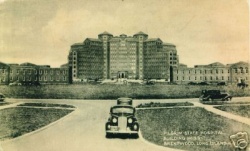Difference between revisions of "Portal:Featured Image Of The Week"
From Asylum Projects
M-Explorer (talk | contribs) |
M-Explorer (talk | contribs) |
||
| Line 1: | Line 1: | ||
{{FIformat | {{FIformat | ||
| − | |Image= | + | |Image= Pilgrim State PostCard.jpg |
|Width= 250px | |Width= 250px | ||
| − | |Body= | + | |Body= New york planned the third so-called farm colony, what was to become the [[Pilgrim State Hospital]], named in honor of the former New York State Commissioner of Mental Health, Dr. Charles W. Pilgrim. The state bought up approx. 1,000 acres (4.0 km²) of land in Brentwood and began construction in 1930. The hospital opened on October 1, 1931 as a close knit community with its own police and fire department, courts, post office, a LIRR station, power plant, potter's field, swinery, cemetery, water tower and houses for doctors, psychiatrists, and asylum administrators. A series of underground tunnels were used for routing steam pipes and other vital utilities. |
| − | |||
| − | |||
}} | }} | ||
Revision as of 03:00, 24 May 2010
Featured Image Of The Week
New york planned the third so-called farm colony, what was to become the Pilgrim State Hospital, named in honor of the former New York State Commissioner of Mental Health, Dr. Charles W. Pilgrim. The state bought up approx. 1,000 acres (4.0 km²) of land in Brentwood and began construction in 1930. The hospital opened on October 1, 1931 as a close knit community with its own police and fire department, courts, post office, a LIRR station, power plant, potter's field, swinery, cemetery, water tower and houses for doctors, psychiatrists, and asylum administrators. A series of underground tunnels were used for routing steam pipes and other vital utilities.
